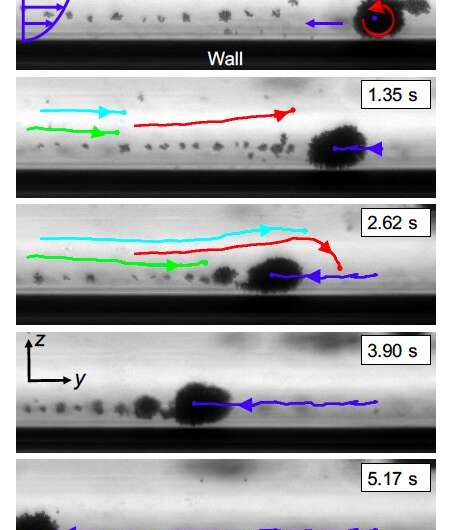Micro-sized robots could bring a new wave of innovation in the medical field by allowing doctors to access specific regions inside the human body without the need for highly invasive procedures. Among other things, these tiny robots could be used to carry drugs, genes or other substances to specific sites inside the body, opening up new possibilities for treating different medical conditions.
Researchers at ETH Zurich and Helmholtz Institute Erlangen–Nürnberg for Renewable Energy have recently developed micro and nano-sized robots inspired by biological micro-swimmers (e.g., bacteria or spermatozoa). These small robots, presented in a paper published in Nature Machine Intelligence, are capable of upstream motility, which essentially means that they can autonomously move in the opposite direction to that in which a fluid (e.g., blood) flows. This makes them particularly promising for intervening inside the human body.
“We believe that the ideas discussed in our multidisciplinary study can transform many aspects of medicine by enabling tasks such as targeted and precise delivery of drugs or genes, as well as facilitating non-invasive surgeries,” Daniel Ahmed, lead author of the recent paper, told TechXplore.
The bio-inspired and wireless micro/nanorobotic systems developed by Ahmed and his colleagues exploit the no-slip boundary conditions of a wall to move upstream, responding to externally triggered acoustic and magnetic fields. By swimming upstream against the blood flow, the robots could be used to deliver small drug molecules to sites inside the body that are particularly hard to reach.
“External-field-induced robots are an attractive concept because they do not require an onboard power supply or intricate moving parts, which means that they can be scaled down to nanometer-sized resolution” Ahmed said. “In addition, both acoustic and magnetic fields are safe for humans, are non-invasive, can penetrate deeply into the human body, and are well-developed in clinical settings.”
By combining acoustic and magnetic fields, the robotic system devised by the researchers could help to overcome some of the issues observed in other artificial micro-swimmers that are based on single actuation techniques. Moreover, as they respond to fields applied outside the body, the micro/nano robots do not require an on-board power supply or highly sophisticated and expensive components.
“Typically, injected tiny agents will follow the vasculature’s bloodstream with little to no control in the circulatory system,” Ahmed explained. “Recent findings, however, have shown that many naturally-occurring microswimmers such as bacteria and spermatozoa exhibit propulsion against the flow by exploiting the nonslip boundary conditions of the wall. Upstream motion becomes possible because the velocity at the wall is minimum.”

So far, the use of micro- or nano-sized robots in medicine has been limited, particularly within the vascular system (i.e., the vessels through which blood and lymph travel throughout the body). One reason for this is that robots operating in the vascular system should be easily controlled in a non-invasive way and should be able to move in the opposite direction to that in which the blood flows, two characteristics that have so far proved fairly difficult to achieve.
The new robotic system developed by Ahmed and his colleagues has both of these qualities, as it is capable of upstream motility and is controlled using externally applied acousto-magnetic fields. In the future, this recent study could thus open up new exciting possibilities for performing targeted surgeries or delivering substances to specific sites within the body through the vascular system.
“The blood flow velocity in small animal models, such as rat, mouse, and zebrafish, is in the range of a few mms−1,” Ahmed said. “We now plan to incorporate our swarm microrobotic systems with appropriate imaging modality to visualize and navigate robots in vivo in small animals. The ability to propel against flows can provide exciting opportunities for application in targeted therapeutics in the tumor vasculature.”
Bioinspired micro-robot based on white blood cells
More information:
Bioinspired acousto-magnetic microswarm robots with upstream motility. Nature Machine Intelligence(2021). DOI: 10.1038/s42256-020-00275-x.
2021 Science X Network
Citation:
Tiny bio-inspired swarm robots for targeted medical interventions (2021, January 25)
retrieved 25 January 2021
from https://techxplore.com/news/2021-01-tiny-bio-inspired-swarm-robots-medical.html
This document is subject to copyright. Apart from any fair dealing for the purpose of private study or research, no
part may be reproduced without the written permission. The content is provided for information purposes only.



